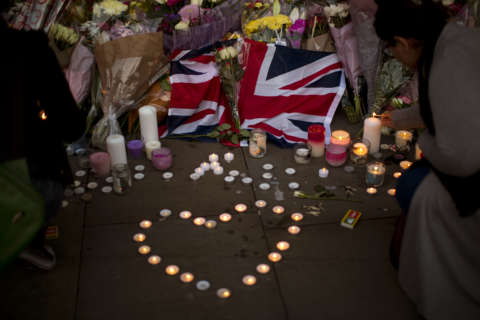WASHINGTON — The Islamic State of Iraq and the Levant (ISIS) is running out of territory, money, fighters and time; but experts fear the damage has already been done.
Three years after its stunning and brutal confiscation of thousands of miles of territory in Iraq and Syria, ISIS’ so called “caliphate,” while crumbling under withering international military pressure, has spawned a complex, global, terror threat that authorities are struggling to contain.
“This terrorist phenomenon is very flexible,” said Manuel Navarette, director of Europol’s European Counter Terrorism Centre. “We have suffered from terrorists attacks conceived, prepared and carried out in a very professional way in Paris, Brussels in the last 18 months.”
But the three deadly attacks in Britain in the last four months are a type of low-tech, high-impact form of terrorism sweeping Europe that he acknowledged presents a difficult challenge.
“We also suffer from the ‘lone actor’ phenomenon,” he said. “They are inspired by terror groups like the Islamic State to launch attacks at home, with no clear connection to ISIS.”
Robin Simcox, Margaret Thatcher Fellow at the Heritage Foundation, believes the group’s ruthless brand of terrorism will likely continue to proliferate globally, even after its enclaves in Mosul, Iraq and Raqqa, Syria, have been eradicated.
“Their brand is essentially unaffected by the fact that they don’t hold as much territory as they used to,” Simcox said. “The tempo of attack isn’t slowing down.”
Citing the recent attacks in Manchester, London, Paris and Tehran as proof, he suggested that the group has already successfully jumped from the terrestrial to the virtual world.
“The ideology that ISIS represents and attempts to get others to follow, still has a lot of legs in it. And until that ideology stops being appealing, then you’re going to see ISIS and its offshoots continue to reappear,” Simcox said.
But Simcox said ISIS’ penchant for brutality is also responsible for its demise.
“Every day in the summer of 2014, you had this stream of constant beheadings, and they telegraphed who would be next and it essentially meant that the U.S. government and the U.K. and other governments had little choice but to engage.”
Estimated to be worth close to 2 billion dollars in 2014, U.S. military officials now say the group has lost most of its sources of revenue linked to the territory it controlled. It’s not able to sell the oil in Iraq, and it is no longer able to tax people in areas it no longer controls.
In fact, ISIS’ own numbers have dwindled significantly.
“In Mosul, we assess that there are less than a thousand fighters left,” said U.S. Army Col. Ryan Dillon, a spokesman for Operation Inherent Resolve. “There is absolutely nowhere that they can go. They have two choices. They can surrender or they can die.”
He attributes the reduction in ISIS forces to the overwhelming power of the U.S. led coalition and the Iraqi forces fighting against ISIS, but he also believes ISIS leadership has given up on Mosul.
“We’ve seen this many times when ISIS leaders will sneak out of a particular area and leave the fighting to the foreign jihadist that will fight to the death,” said Dillon.
That extreme commitment by those faithful to ISIS’ ideology worries researchers tracking the rise and fall of ISIS because thousands of those trained in Iraq and Syria have returned to their home countries — many with a grudge.
Nikita Malik, senior researcher with the Henry Jackson Society in London expressed concern about the return flow. “In the United Kingdom, we’ve had 850 fighters who have traveled to Iraq and Syria, of which half, approximately 400 to 450 people, have returned to the United Kingdom, and they are British citizens.”
Their British passports, according to Malik, coupled with violent tendencies present a real threat to U.K. society “because they are radical enough to go out and join these jihadist groups, but then on top of that you have people who have not joined but who empathize and believe in the cause of violent ideology.”
Malik noted that the March 22 attack in Westminster and the June 3 London bridge attack proves jihadists learn from each other.
“One thing that was troubling was the scale of the attack that three individuals were involved in [on June 3], and they use the same methods as the person in Westminster and the use of a van plus knives that were so easily available.”
ISIS has had three years to raise money, train fighters and build its brand; and while it experienced unprecedented success as a terror organization in its so called “caliphate”, its days appear to be numbered in Syria and Iraq.
With the fight in Mosul well in hand, the U.S. led coalition has set its sights on Raqqa. Dillon, while not making a judgment on how that will impact ISIS activities in other locations around the world, is clear that when it falls, ISIS standing in the jihadist world will plummet as well.
“Raqqa was the planning location for the Paris and Berlin attacks. It’s the de facto capital for the so-called ‘caliphate,’ and this will be a big blow to their prestige,” said Dillion.
But as the military continues squeezing ISIS in the Middle East, Navarette said his agency is sharpening its skills for what lays ahead.
“It’s remarkable how the European Union counterterrorism services have prevented so many terror attacks in the last 18 months because terrorists have become faster in their planning and attacks. And our challenge now is to develop intelligence faster, so we can disseminate it to our members faster.”
Navarette said that process will make terrorists and their plots more predictable. “And, by making them predictable we can make them preventable.”







